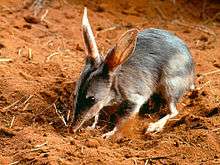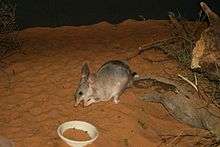Macrotis
Macrotis is a genus of desert-dwelling marsupial omnivores known as bilbies or rabbit-bandicoots;[3] they are members of the order Peramelemorphia. At the time of European colonisation of Australia, there were two species. The lesser bilby became extinct in the 1950s; the greater bilby survives but remains endangered. It is currently listed as a vulnerable species. It is on average 55 cm (22 in) long, excluding the tail, which is usually around 29 cm (11 in) long. Its fur is usually grey or white, it has a long pointy nose and very long ears, hence earning its nick-name, the rabbit-eared bandicoot.

Bilby-5.jpg)
| Macrotis | |
|---|---|
 | |
| Greater bilby at Monarto Zoo | |
| Scientific classification | |
| Kingdom: | Animalia |
| Phylum: | Chordata |
| Class: | Mammalia |
| Infraclass: | Marsupialia |
| Order: | Peramelemorphia |
| Family: | Thylacomyidae Bensley, 1903 |
| Genus: | Macrotis Reid, 1837 |
| Type species | |
| Perameles lagotis Reid, 1837[1] | |
| Species | |
| Synonyms | |
|
Paragalia Gray, 1841 | |
Taxonomy
Macrotis means ‘big-eared’ (macro- + ōt- ‘ear’) in Greek, referring to the animal's large, long ears.[4] The genus name was first proposed as a subgeneric classification, which after a century of taxonomic confusion was eventually stabilised as the accepted name in a 1932 revision by Ellis Troughton. In reviewing the systematic arrangement of the genus, Troughton recognised three species names, including one highly variable population with six subspecies.[5]
The family's current name Thylacomyidae is derived from an invalid synonym Thylacomys, meaning 'pouched mouse', from the Ancient Greek thýlakos (θύλακος, 'pouch, sack') and mys (μῦς, 'mouse, muscle'),[3] sometimes misspelt Thalacomys.[6][7]
The term bilby is a loanword from the Yuwaalaraay Aboriginal language of northern New South Wales, meaning long-nosed rat. It is known as dalgite in Western Australia, and the nickname pinkie is sometimes used in South Australia.[8] The Wiradjuri of New South Wales also call it "bilby".[9] Gerard Krefft recorded the name Jacko used by the peoples of the lower Darling in 1864, emended to Jecko in 1866 along with Wuirrapur from the peoples at the lower Murray River.[5]
Classification
The placement of the population within taxonomic classification has changed in recent years. Vaughan (1978) and Groves and Flannery (1990) both placed this family within the family Peramelidae. Kirsch et al. (1997) found them to be distinct from the species in Peroryctidae (which is now a subfamily in Peramelidae). McKenna and Bell (1997) also placed it in Peramelidae, but as the sister of Chaeropus in the subfamily Chaeropodinae.[10]
A summary of the treatment as a peramelemorph family is,
- Thylacomyidae
- Genus Macrotis
- Macrotis lagotis, extant
- Macrotis leucura, extinct
- Chaeropodidae (pig-footed bandicoots, extinct)
- Peramelidae (genera known as bandicoots, extant and extinct)
Fossil taxa allied to the family are,
- Genus †Ischnodon
- †Ischnodon australis[11]
- Genus †Liyamayi
- †Liyamayi dayi[12]
Description
Bilbies have the characteristic long bandicoot muzzle and very big ears that radiate heat. They are about 29–55 cm (11–22 in) long. Compared to bandicoots, they have a longer tail, bigger ears, and softer, silky fur. The size of their ears allows them to have better hearing.[13][14] They are nocturnal omnivores that do not need to drink water, as they obtain their moisture from food, which includes insects and their larvae, seeds, spiders, bulbs, fruit, fungi, and very small animals. Most food is found by digging or scratching in the soil, and using their very long tongues.
Unlike bandicoots, they are excellent burrowers and build extensive tunnel systems with their strong forelimbs and well-developed claws. A bilby typically makes a number of burrows within its home range, up to about a dozen, and moves between them, using them for shelter both from predators and the heat of the day. The female bilby's pouch faces backwards, which prevents the pouch from getting filled with dirt while she is digging.
Bilbies have a gestation of about 12–14 days, one of the shortest among mammals.[15]
The appearance of the bilby has been alluded to as an Australian easter bunny.[16]
Conservation
Bilbies are slowly becoming endangered because of habitat loss and change, and competition with other animals. There is a national recovery plan being developed for saving them. This program includes captive breeding, monitoring populations, and reestablishing bilbies where they once lived. There have been reasonably successful moves to popularise the bilby as a native alternative to the Easter Bunny by selling chocolate Easter Bilbies (sometimes with a portion of the profits going to bilby protection and research). Reintroduction efforts have begun, with a successful reintroduction into the Arid Recovery Reserve in South Australia in 2000,[17][18] and a reintroduction into Currawinya National Park in Queensland, where six bilbies were released into a predator-proof enclosure in April 2019.[19]
Successful reintroductions have also occurred on the Peron Peninsula in Western Australia as a part of[20] the Western Shield program, and at other conservation lands, including islands and the Australian Wildlife Conservancy's[21] Scotia[22] and Yookamurra Sanctuaries.[23] There is a highly successful bilby breeding program at Kanyana Wildlife Rehabilitation Centre[24] near Perth, Western Australia.
Evolution
The bilby lineage extends back 15 million years.[25] In 2014 scientists found part of a 15-million-year-old fossilised jaw of a bilby which had shorter teeth that were probably used for eating forest fruit. Prior to this discovery, the oldest bilby fossil on record was 5 million years old. Modern bilbies have evolved to have long teeth used to dig holes in the desert to eat worms and insects.
It is thought the bilby diverged from its closest relative, an originally-carnivorous bandicoot, 20 million years ago.[26]
See also
- Australian fauna
- Boj (TV series), animated cartoon featuring a bilby as a character
- Bilby (Film) Animated short made by Dreamworks Animation
References
- Reid, J. (1837). "Description of a new species of the genus Perameles (P. lagotis)". Proceedings of the Zoological Society of London. 1836: 129–131.
- Wilson & Reeder. "Genus Macrotis". Mammal Species of the World.
- "Thylacomys". Merriam-Webster Dictionary. Unabridged (subscription required)
- Turner, Jim (2004). Mammals of Australia. Pensoft Publishers. p. 39. ISBN 978-954-642-198-2.
- Troughton, E. (1932). "A revision of the rabbit-bandicoots. Family Peramelidae, genus Macrotis". The Australian Zoologist. 7: 219–236.
- "Thalacomys". Nomenclator Zoologicus Record. The Marine Biological Laboratory. Archived from the original on 1 January 2015. Retrieved 25 September 2014.
err. pro Thyl- Owen 1838
- Waite, Edgar R. (1900). "The generic name Thylacomys". Annals and Magazine of Natural History. Series 7. 5 (26): 222–223. doi:10.1080/00222930008678272.
- "Home - Australian National Dictionary Centre". ANU. Archived from the original on 18 February 2007. Retrieved 22 April 2014.
- Archived 28 September 2006 at the Wayback Machine
- Groves, C. P. (2005). Wilson, D. E.; Reeder, D. M. (eds.). Mammal Species of the World: A Taxonomic and Geographic Reference (3rd ed.). Baltimore: Johns Hopkins University Press. p. 38. ISBN 0-801-88221-4. OCLC 62265494.
- Stirton, R.A., 1955. Late tertiary marsupials from South Australia. Records of the South Australian Museum 11, 247-268.
- Travouillon, K.J.; Hand, S. J.; Archer, M.; Black, K. H. (2014). "Earliest modern bandicoot and bilby (Marsupialia, Peramelidae and Thylacomyidae) from the Miocene of the Riversleigh World Heritage Area, northwestern Queensland, Australia". Journal of Vertebrate Paleontology. 34 (2): 375–382. doi:10.1080/02724634.2013.799071.
- "Greater bilby". Department of Environment and Science - Queensland Government. 8 August 2003. Retrieved 23 April 2019.
- "Bilby - Australia's Easter bunny". Environmental Protection Agency/Queensland Park and Wildlife Service. 24 November 2005. Archived from the original on 23 March 2006. Retrieved 23 April 2019.
- Gordon, Greg (1984). Macdonald, D. (ed.). The Encyclopedia of Mammals. New York: Facts on File. pp. 846–849. ISBN 978-0-87196-871-5.
- University of Queensland (17 March 2014). "Palaeontologists unearth rare 15-million-year-old bilby". UQ News.
- Moseby K. E. and O'Donnell E. O. (2003) Reintroduction of the greater bilby, Macrotis lagotis (Reid) (Marsupialia: Thylacomyidae), to northern South Australia: survival, ecology and notes on reintroduction protocols Wildlife Research 30, 15-27.
- "Greater Bilby". www.aridrecovery.org.au. Retrieved 23 April 2019.
- Caldwell, Felicity (18 April 2019). "Bilbies hop into their new home just in time for Easter". Brisbane Times. Retrieved 23 April 2019.
- "Western Australian Department of Environment and Conservation 'Project Eden'". Naturebase.net. Archived from the original on 31 August 2007. Retrieved 22 April 2014.
- "Australian Wildlife Conservancy". Awc.org.au. Archived from the original on 23 May 2017. Retrieved 22 April 2014.
- Australian Wildlife Conservancy Scotia Sanctuary
- Australian Wildlife Conservancy Yookamurra Sanctuary
- "Kanyana Wildlife Rehabilitation Centre (Inc.)". Kanyanawildlife.org.au. Archived from the original on 29 June 2009. Retrieved 22 April 2014.
- 15-million-year-old bilby fossil found in Qld, Australian Geographic.
- Carnivorous bilby fossil unearthed, Australian Geographic.
External links
| Wikimedia Commons has media related to Macrotis. |
| Look up bilby or Macrotis in Wiktionary, the free dictionary. |